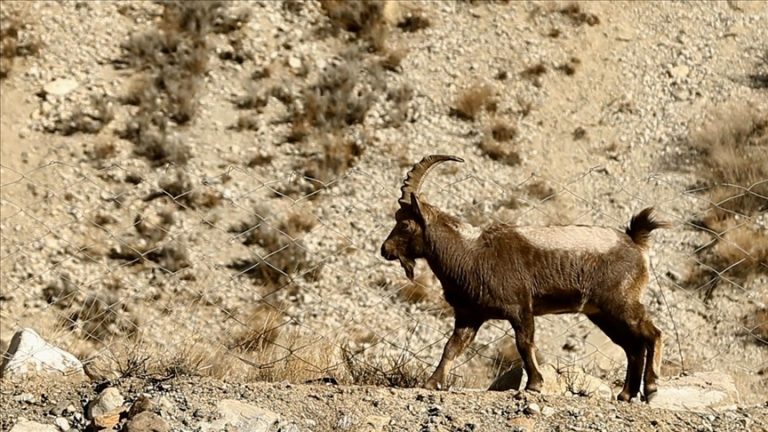
‘Markhor population has been increasing with an annual ratio of 2% since 2014,’ International Union for Conservation of Nature official tells
Aamir Latif
KARACHI, Sindh Pakistan
A sustainable trophy hunting program and greater community involvement have helped Pakistan maintain a years-long trend of an increase in the population of its national animal, the markhor, according to government and international conservation officials.
Once believed to be on the brink of extinction, markhor numbers have gradually increased, doubling in a couple of decades, with a particular jump since 2014.
This is now the 10th straight year that numbers of the long-horned wild goat have grown, marking a milestone in local conservation efforts.
“The population of the markhor has been increasing with an annual ratio of 2% since 2014,” Saeed Abbas, an official with the International Union for Conservation of Nature (IUCN) in Pakistan, told Anadolu.
Around the world, however, their numbers are declining, mainly due to a lack of adequate conservation programs, he added.
Another potential downside, he said, is that because of the continued rise in Pakistan’s markhor population the animal’s global status has been downgraded from “endangered” to “near-threatened.”
The IUCN classified the markhor as an endangered species in 1994 due to overhunting for its meat and horns, and its population was estimated to be less than 2,500 at that time.
The number of mature markhors in Pakistan surpassed 2,500 in 2014, which prompted the conservation agency to downgrade the threat level in line with international wildlife standards, said Abbas.
Pakistan is famous for the markhor, which is distinguished by its nimble and sure-footed nature, as well as long winter coat and massive spiral horns, which can grow to more than 1.5 meters (5 feet) in length for males.
They inhabit the highest mountains and can be found in the northwestern Khyber Pakhtunkhwa (KP) province’s Chitral, Kohistan and Kalam regions, as well as the northern Gilgit-Baltistan region, southwestern Balochistan province and parts of Pakistan-administered Kashmir.
“An annual rise in population between 1.5% and 2% is viewed as a healthy increase in case of threatened animals like markhor,” Abbas explained, adding that harsh conditions, illegal hunting, poaching and predators altogether make it difficult for the wild goat to survive.
The markhor’s current estimated population is between 3,500 and 5,000, a majority of them in KP, followed by Gilgit-Baltistan and Balochistan, he said.
Locally, the goats are categorized as Astor, Kashmiri, Suleiman and Chiltan markhors, whereas globally, Astor and Kashmiri markhors are classified as flare-horned.
Trophy hunting: Bane or boon?
The Gilgit-Baltistan government, earlier this week, granted a permit to hunt an Astor markhor for a record $186,000, one of the highest permits in the world to kill an animal.
The previous record for a markhor hunting license in Pakistan was $160,000 in 2021.
The government uses the money to support local communities with initiatives such as building schools, mosques, health centers and even providing scholarships to students.
About 80% of the amount generated through the hunting license program, launched in early 2000, is spent on local communities, while the remainder goes to the national exchequer.
The incentives encourage local communities to avoid killing markhors and instead pushes them to care for the animals, according to Syed Altaf Shah, an official of the KP Wildlife Department.
“Trophy hunting has reduced poaching and hunting of markhor to a great extent as the local communities themselves started protecting the animal after it became a source of income,” Shah told Anadolu.
Hunting female or young markhor is prohibited.
According to local laws, any hunter who kills a female or a young markhor faces a six-year prison sentence, a fine of up to 150,000 Pakistani rupees ($850), or both, said Shah.
The law, however, is rarely implemented.
Wildlife lovers view trophy hunting as a controversial practice as it involves hunting rare animals for sport and displaying parts as trophies.
Abbas, however, feels that the program has helped protect rare animals, including the markhor, from illegal hunting and poaching.
Salary rift triggers numbers row
A salary dispute between the government and local conservators sparked a controversy over Pakistan’s markhor population.
In the 2021-22, locals hired as conservators to protect the wild goat claimed that the number of markhors had actually decreased despite the ban on hunting and other conservation efforts.
The claim prompted the government to involve the IUCN and other wildlife organizations to conduct a new survey to verify the assertion.
“We carried out a fresh survey to ascertain the veracity of the claim. The latest findings and headcounts, however, suggested that the population of the animal has actually increased,” said Abbas, who was a member of the survey team.
In 2017, according to a wildlife official who spoke on condition of anonymity, the government had stopped paying salaries to scores of members of village conservation committees.
That prompted the controversy as those people wanted to “settle the score,” the official contended.
________________
Aamir Latif is a senior journalist based in Karachi. He represents Anadolu, a Turkish news agency.
Courtesy: Anadolu Agency (Posted on 01.11.2023)